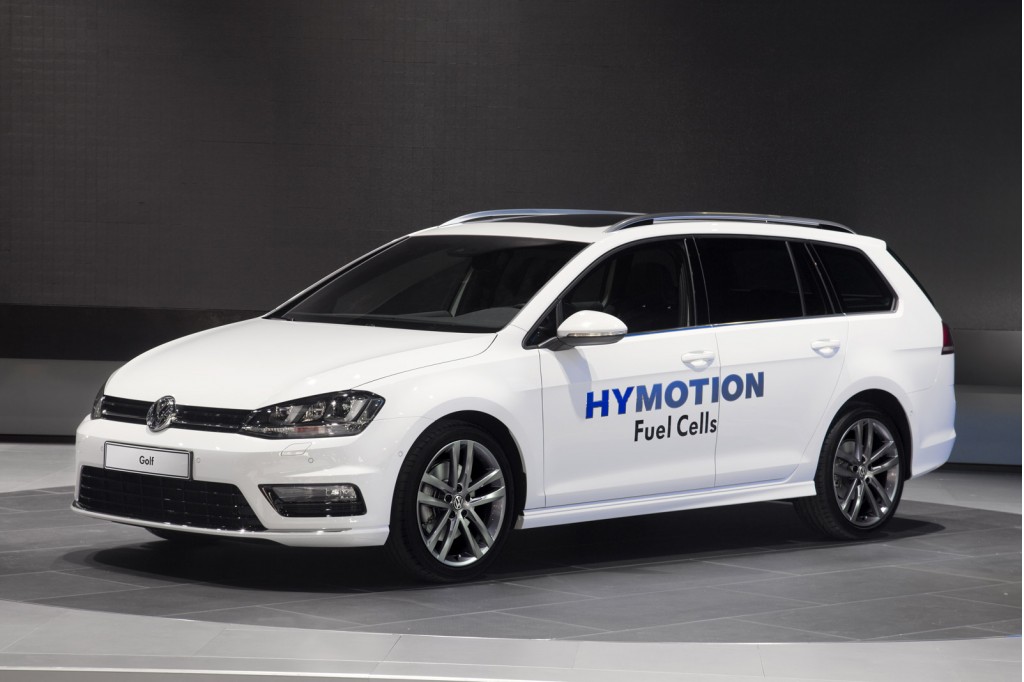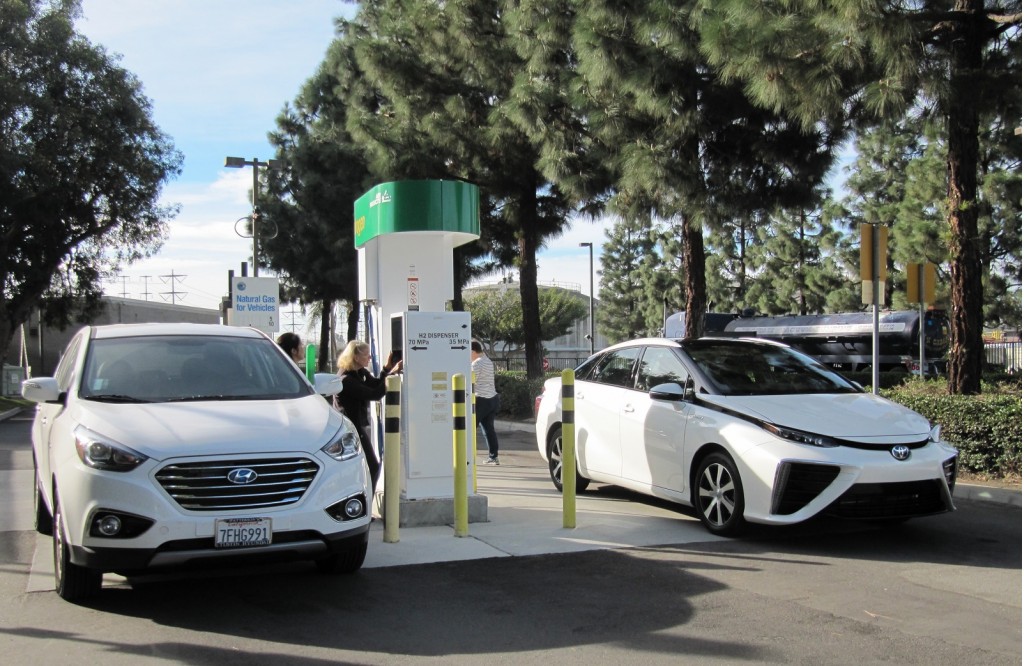The biggest news in zero-emission vehicles at last month's Los Angeles Auto Show was the formal introduction of the 2016 Toyota Mirai.
But several other companies made news in the hydrogen fuel-cell market as well.
Here's our brief roundup of the hydrogen stories we covered in LA.

2016 Toyota Mirai hydrogen fuel-cell car, Newport Beach, CA, Nov 2014
The maker of the world's highest-volume hybrid, the Toyota Prius, formally introduced the production version of its hydrogen fuel-cell vehicle.
Like the first-generation Prius, the 2016 Toyota Mirai (the Japanese word for "future") will be a low-volume vehicle in its early years.
But Toyota is firmly convinced that fuel-cell vehicles running on highly compressed hydrogen will be the zero-emission technology "for the next half-century," not battery-electric cars.
And like other makers of hydrogen powered vehicles, Toyota is helping to fund the development of a hydrogen fueling infrastructure to serve them--initially in Southern California.

Honda FCV Concept
Carmakers fund fueling infrastructure
Honda, too, plans to launch a fuel-cell vehicle sometime next year, expected to go on sale in 2016.
The smaller Japanese carmaker doesn't echo Toyota's adamant position that hydrogen vehicles are the sole solution; Honda says there's room for electric cars too.
But it will also loan $14 million to First Element Fuel, a startup company that has won contracts from the state of California to install a network of hydrogen fueling stations.
Honda's funds will help build 12 hydrogen stations in Southern California; Toyota had previously said it would loan First Element its own $7.3 million for the first 19 stations.
In turn, Toyota said in LA that it would also provide funds to Air Liquide to build 12 stations in five Northeast states: Connecticut, Massachusetts, New Jersey, New York, and Rhode Island.

Volkswagen Passat HyMotion hydrogen fuel cell prototype - Los Angeles, November 2014
Volkswagen Passat HyMotion prototype
To demonstrate that its hydrogen fuel-cell hardware was ready for the road, VW took a current-generation U.S. Passat and converted it to run on a fuel cell.
We drove the prototype, briefly, and found it fully as refined as the Mirai and quieter in some ways.
The company says, however, that it only expects to introduce models powered by hydrogen where a fueling infrastructure already exists and where there's clear demand.

Volkswagen Golf SportWagen HyMotion concept, 2014 Los Angeles Auto Show
Volkswagen Golf SportWagen HyMotion concept
On its stand, Volkswagen displayed a second hydrogen vehicle.
This one, an adaption of its new Golf wagon, showed how hydrogen fuel tanks and a fuel-cell stack could be integrated into the company's MQB architecture without any compromise in space for people or cargo.
The 2015 VW Golf SportWagen will be offered in the U.S. powered by gasoline or TDI diesel engines. It replaces the previous Jetta SportWagen.

Volkswagen Golf SportWagen HyMotion concept, 2014 Los Angeles Auto Show
But Volkswagen has designed its underpinnings to handle a striking array of fuels, including hydrogen.
The tanks sit under the cargo bay and rear seat, and the fuel-cell stack and electric drive motor sit in the engine compartment.
The motor comes from the 2015 Volkswagen e-Golf, and the lithium-ion battery pack (to smooth transient power demands) from the VW Jetta Hybrid.

Audi A7 h-tron quattro, 2014 Los Angeles Auto Show
Audi A7 h-tron quattro concept
Under VW Group's luxury Audi brand, hydrogen was used to power a plug-in hybrid concept that delivered 15 or 20 miles of battery-electric power before switching over to the fuel cell.
While this setup is even more expensive than a regular fuel-cell vehicle, Audi built its concept to demonstrate that hydrogen vehicles could deliver performance as well as zero-emission travel.
Its two electric motors, one per axle, delivered quattro all-wheel drive, while the 8.8-kilowatt-hour battery provided energy for sustained full-bore acceleration when needed--and recharged itself from the fuel cell output under normal circumstances.

2016 Toyota Mirai hydrogen fuel-cell car, Newport Beach, CA, Nov 2014
Hyundai Tucson Fuel Cell
Finally, Hyundai had its hydrogen-powered Tucson crossover utility vehicle on display at the Los Angeles show as well.
The Korean maker didn't provide any new information on that car, which began leasing in June--making it the first of a new generation of hydrogen fuel-cell vehicles to hit California roads.
It did, however, issue a brochure to the news media that reprinted its responses to Green Car Reports' 10 questions for makers of hydrogen fuel-cell cars.
That article, which continues to generate traffic and comments, highlighted some of the issues that Toyota, Hyundai, and Honda must address as they roll out their hydrogen powered vehicles.
_______________________________________________












